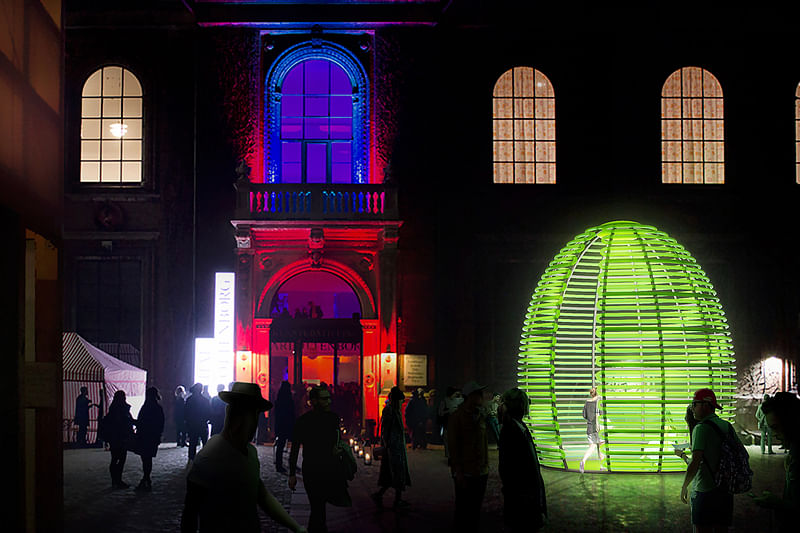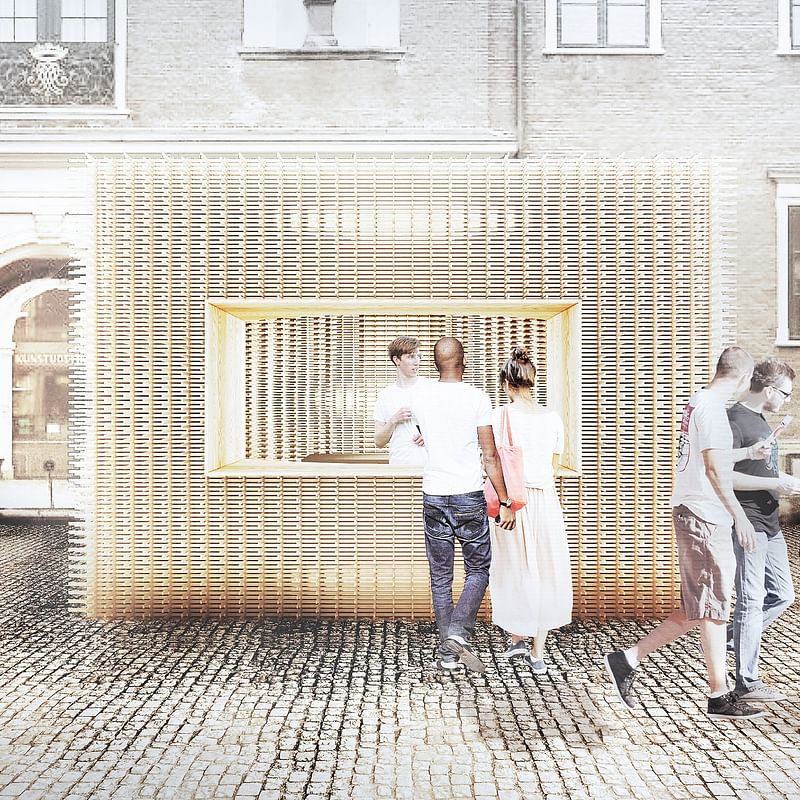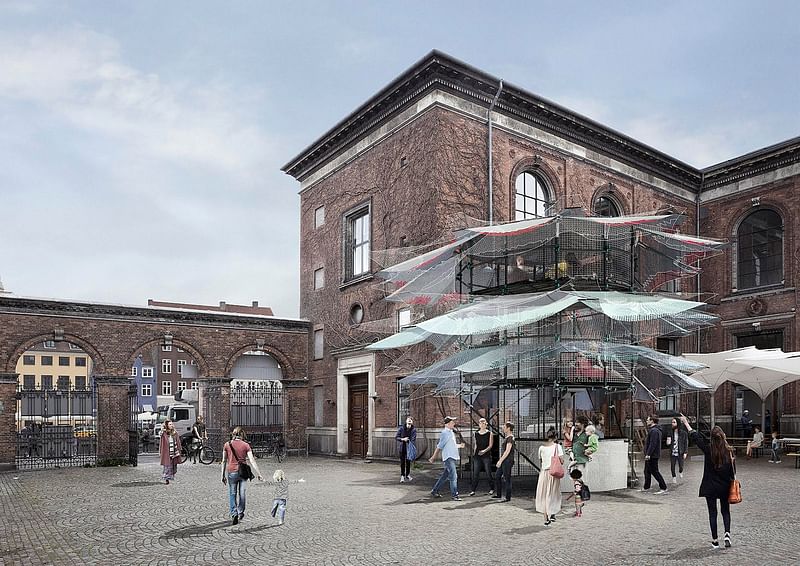From Ikea bags to algae to trusty ol' paper, here are the 2017 CHART ARCHITECTURE finalist proposals
By Justine Testado|
Thursday, Apr 27, 2017

Related
Launched in 2014 by Chart Social to promote young Nordic architects, the 2017 CHART ARCHITECTURE competition welcomed applications from young and newly established architectural practices as well as students and recent grads from Nordic architecture schools.
The competition's 2017 “The Living City” theme revolves around promoting public awareness of sustainable urbanization. Participants had to propose a sustainably designed pavilion for the Chart Art Fair's gastronomy partners and SPACE10 that considers upcycling and reusing materials, multifunctionality, and innovative fabrication methods. Most recently, five teams were announced as the finalists.
The distinguished jury (listed below) will pick the winning proposal, which will be announced on September 2 during the art fair. The lucky winning designers will be offered a mentorship program with a professional architect, a construction expert, and developer.
See the finalist proposals below!

Algae Dome by Aleksander Wadas, Rafal Wroblewski, and Anna Stempniewicz
Pavilion Design: Space10
Residence: Gdansk (Poland) and Copenhagen
School: The Royal Academy Of Fine Arts – Kadk 2016
Project description: “We propose a pavilion that is a simple and direct translation of a photo-bioreactor’s diagram into architecture. By arranging the tubular system with algae into a dome-like shape we create a pavilion that functions as a photo-bioreactor. The very utilitarian and technological infrastructure becomes architecture. It’s inviting, yet enclosed form provides shelter and creates oasis for social interaction.”

Paper Pavilion by Kazumasa Takada, Yuriko Yagi, and Yohei Tomioka
Team Name: Yata
Pavilion Design: Gastronomy
Residence: Copenhagen
School: The Royal Academy Of Fine Arts - Kadk 2017
Project description: “For the theme of Sustainability, we set up the design goal to create a pavilion which has an appropriate durability for an event which to be held for a short time like CHART. We believe for a sustainable future it is necessary to reconsider the excesses acts of our daily life and adjust them appropriately. Therefore, by designing a pavilion with an appropriate architectural durability rather than using a material with excessive strength, which is often the case for this type of pavilion, the proposal attempts to imply a message against such excess. The paper pavilion is intentionally designed to be able to last a week rather than three months, for example.”

Stick Box by Miki Morita, Suguru Kobayashi, Keita Shishijima
Team Name: Mok+S Architects
Pavillion Design: Gastronomy
Residence: Copenhagen
School: The Royal Academy Of Fine Arts – Kadk And Kanagawa Univ / Kit Japan
Project description: “This pavilion project aims to work as a prototype using smaller timber modules made from forest thinning and left over wood from lumbering which is not usually regarded as an architectural material. We hope that people, when experiencing the pavilion, will feel the familiar sized piece of the material and how it can potentially become an architectural material and create awareness about the environmental problem of forest thinning around the world.”

Sunday Temple by Mia Frykholm and Astrid Gabrielsson
Team Name: M + A
Pavillion Design: Gastronomy
Residence: Copenhagen
School: The Royal Academy Of Fine Arts - Kadk 2016 / 2017
Project description: “Ritual spaces have come to have a new purpose in our society. The shape of the pavilion is a reference to the Hampi temple in India. Today the religious and ceremonial spaces have in many cases been replaced by something else - instead of going to church on Sundays we take a ritual walk through IKEA’s warehouse or do our laundry comfortable with the familiar blue bag. The blue IKEA bag is a symbol in society - the laundry bag that is an essential reminder of Sunday laundry rituals. It’s made to be durable / cheap / ideal size, to be mass-produced and spread worldwide. A simple wood support structure is used to create a temple embedded with the blue bags and labelled handles hang as ornaments. By mounting the bags on a supporting structure, to take the shape of a temple, they will bring another form of representation. The openings of the bags are being suspended pointing in different directions so that when the wind fills the bags, the facade will come to life and have a constant moving or waving face. With lights inside, the pavilion will emit a blue glow during night-time.”

Adapt by Harry Clover, Jack Cripps, Sebastian Gatz and Fabian Puller
Team Name: Ccgp
Pavilion Design: Gastronomy
Residence: Copenhagen
School: The Royal Academy Of Fine Arts - Kadk 2017/18
Project description: “ADAPT is a pavilion which opens itself as the day warms and closes itself as the day cools without the need for external sources of energy, like a plant. It promotes a revolutionary new form of architecture that regulates itself independently and adapts spatially as a result of the kinetic performance of the materials from which it is made. ADAPT is the forerunner of a living city of buildings which lean, open or retract, changing form, function and regulatory state without the need to be connected to energy grids, taking the sustainability of buildings to the next level.”
2017 jury: Bjarke Ingels, architect and founder of BIG Bjarke Ingels Group; Bjørnstjerne Christiansen, co-founder of SUPERFLEX; Claus Andersen, owner of Andersen’s Contemporary; Débora Mesa, architect and Principal of Ensamble Studio; Dorte Foss, architect; Klaus Kastbjerg, CEO and director of Union Holding A/S; and Simon Frommenwiler, architect and cofounder of HHF Architects

Share
0 Comments
Comment as :